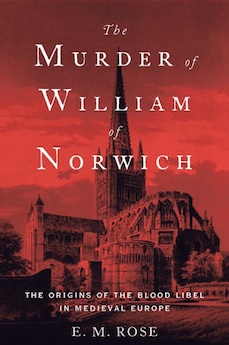Winner of the 2016 Ralph Waldo Emerson Award
By Lewis Fried
In 1150, Thomas of Monmouth, a Benedictine monk, offered an account of the death, in 1144, of a young apprentice leatherworker named William. Thomas’ The Life and Passion of Saint William of Norwich became the seminal work in a medieval tradition that still exists: the blood libel. The elements of this are crude and malicious: Jews would murder a non-Jew, and in the libel’s successive elaborations throughout the centuries, drain his blood, and use it in rituals or to make matzoh. We come to have an indictment of Jews, their faith, and their lives.
Rose’s work is doubly important. First, it places the murder in the confluence of personality, economics, politics, and faith. By doing so, we no longer have a simple homicide—and in its bare facts a quite uninteresting one—but an anatomy of a society. Although the libel boggles human rationality (and this challenge to reason is perhaps what makes it so durable), it, and its analogues, live in the sediment of civilizations; the charge advances interests. It is an exploitable item, good for all seasons. Second, we have an illuminating, detailed investigation into the factors leading to persecutions; in specific, of the Jews in medieval Europe. Rose explores the further accusations erupting in Gloucester, Blois, Bury St. Edmunds, and Paris.
The bare bones of the primary case: William followed a man who was offering him a job working for the archdeacon’s cook. The youth was taken to a house owned by a prominent Jew, underwent “all the tortures of Christ,” and was murdered. Quickly, Rose leaves us with an astonishing image: the boy, “crowned with thorns,” a “knotted rope around his head,” and a gag stuffed in his mouth. His disfigured corpse, taken into the woods, and hung up, was eventually chanced upon. A gruesome commentary in itself, Thomas used it in the recounting of yet another tale, that of a Jewish banker’s murder. A knight, in debt to the lender, was the accused killer. His defender, William Turbe, transformed the death into retributive justice. As Rose explains, Turbe, the knight’s bishop, demanded before a royal court in London, that “the slain banker and the entire Jewish community…be charged with killing young William.” In the wake of this, Brother Thomas composed his account. And so, William, not well remembered in his immediate death, became a recognized martyr years after his demise.
This kernel is at the core of the blood libel: the Jew, an account of the murder of a gentile, an animated accusation by a Christian. Yet Rose is much more interested—and here is the great virtue and brilliance of his account—in the currents which swept over the facts; Rose demonstrating that the context, and what we can call somewhat weakly “the interpretive spirit of the times,” can and should be investigated, because they reveal both what is at stake and the significance of the stake itself.
The first part of this engaging, and brilliant study centers on location in the largest sense of the term. We have the chief personalities; motivations for accusations; the examination of the economics of Norwich in trade, its bid for civic importance involving the need for a local martyr and relics; the impact of the Second Crusade; and the consequences of what people chose to ignore and what they decided to believe. There are yet more factors Rose discusses, but the aforementioned easily can subsume them.
The blood libel spread across medieval Europe, and Rose gives us other, salient examples, revealing the power of those who spread it, ranging from open extortion to butchery. In Blois, there was a public burning of thirty Jews. In 1181, in Bury St. Edmunds, the accusation of ritual murder is raised, and close to a decade after, fifty Jews are murdered. In Paris, under the rule of Philip, we have a now-classic and hardening pattern: “rumors[against the Jews], specific accusation, captio, extortion, expulsion.”
Rose offers the reader a penetrating study of how, in one epoch, the social imagination is formed and used. His investigation, meticulous and cautious, shows what can be teased out from the “paucity of documentation” available to the scholar. As a result, this eminently readable book is a model for historical investigation and civic reconstruction. Sadly, charges akin to such falsehoods are still applied to what we can term minorities of convenience. I add this last point; although outside Rose’s concern, it is well within the book’s sphere of influence. As a result, this study, dispassionate and cautionary, also serves well the contemporary moment.
Lewis Fried (ΦBK, Queen’s College, CUNY, 1964) is Professor of English Emeritus at Kent State University and a resident member of the Nu of Ohio chapter of Phi Beta Kappa.




